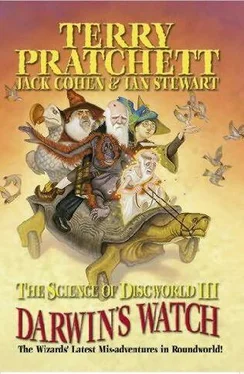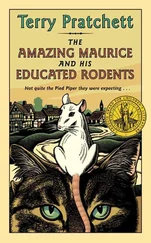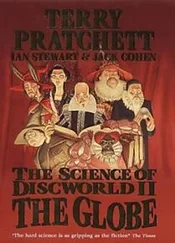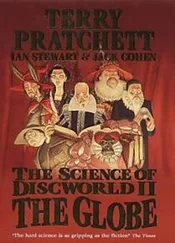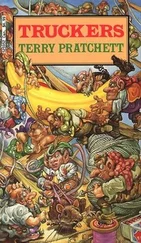Terry Pratchett - The Science of Discworld III - Darwin's Watch
Здесь есть возможность читать онлайн «Terry Pratchett - The Science of Discworld III - Darwin's Watch» весь текст электронной книги совершенно бесплатно (целиком полную версию без сокращений). В некоторых случаях можно слушать аудио, скачать через торрент в формате fb2 и присутствует краткое содержание. Жанр: Фантастика и фэнтези, на английском языке. Описание произведения, (предисловие) а так же отзывы посетителей доступны на портале библиотеки ЛибКат.
- Название:The Science of Discworld III - Darwin's Watch
- Автор:
- Жанр:
- Год:неизвестен
- ISBN:нет данных
- Рейтинг книги:3 / 5. Голосов: 1
-
Избранное:Добавить в избранное
- Отзывы:
-
Ваша оценка:
- 60
- 1
- 2
- 3
- 4
- 5
The Science of Discworld III - Darwin's Watch: краткое содержание, описание и аннотация
Предлагаем к чтению аннотацию, описание, краткое содержание или предисловие (зависит от того, что написал сам автор книги «The Science of Discworld III - Darwin's Watch»). Если вы не нашли необходимую информацию о книге — напишите в комментариях, мы постараемся отыскать её.
The Science of Discworld III - Darwin's Watch — читать онлайн бесплатно полную книгу (весь текст) целиком
Ниже представлен текст книги, разбитый по страницам. Система сохранения места последней прочитанной страницы, позволяет с удобством читать онлайн бесплатно книгу «The Science of Discworld III - Darwin's Watch», без необходимости каждый раз заново искать на чём Вы остановились. Поставьте закладку, и сможете в любой момент перейти на страницу, на которой закончили чтение.
Интервал:
Закладка:
Strictly, the discovery is not so much about the wasps, as about some viruses that infect them ... or are symbiotic with them. They are called polydnaviruses.
When mother wasp injects her eggs into some unsuspecting larva, such as a caterpillar, she also injects a solid dose of viruses, among them said polydnaviruses. The caterpillar not only gets a parasite, it gets an infection. The virus's genes produce proteins that interfere with the caterpillar's own immune system, stopping it reacting to the parasite and, perhaps, rejecting it. So the wasp larvae munch merrily away on the caterpillar, and in the fullness of time they develop into adult wasps.
Now, any self-respecting adult parasitic wasp obviously needs its own complement of polydnaviruses. Where does it get them? From the caterpillar that it fed on. And it gets them (just as mother did) not as a separate infective `organism', but as what is called a provirus: a DNA sequence that has been integrated into the wasp's own genome.
Many genomes, probably most if not all, include various bits of viruses in this way. Our own certainly does. Transport of DNA by viruses seems to have been an important feature of evolution.
In 2004 a team headed by Eric Espagne worked out the DNA sequence of a polydnavirus - as one does - and what they found was dramatically different from what anyone had expected. Typical virus genomes are very different from those of 'eukaryotes'- organisms whose cells have a nucleus, which includes most multi-cellular creatures and many single-celled ones, but not bacteria. The DNA sequences of most eukaryote genes consist of `exons', short sequences that collectively code for proteins, separated by other sequences called introns, which get snipped out when the code is turned into the appropriate protein. Viral genes are relatively simple, and typically they do not contain introns. They consist of connected code sequences that specify proteins.-This particular polydnavirus genome, in contrast, does contain introns, quite a lot of them. The genome is complex, and looks much more like a eukaryote genome than a virus genome. The authors conclude that polydnavirus genomes constitute `biological weapons directed by the wasps against their hosts'. So they look more like the enemy's genome than that of an ordinary virus.
Numerous examples, old and new, disprove every aspect of the folk version of evolution and DNA. We end with one that looks especially important, discovered very recently, and whose significance is just becoming seriously apparent to the biological community. It is probably the most severe shock that cell biology has received since the discovery of DNA and the wonderful `central dogma': DNA specifies messenger-RNA which specifies proteins. The discovery was not made through some big, highly publicised research programme like the human genome project. It was made by someone who wondered why his petunias had gone stripy. When all the world is chasing `the' human genome, it's not easy to get research grants to work on stripy petunias. But what the petunias revealed is probably going to be far more important for medicine than the entire human genome project.
Because proteins are the structure of living creatures, and because as enzymes they control the processes of life, it has seemed obvious that DNA controls life, that we can `map' DNA code on to all the important living functions. We could assign a function to each protein, so we could assume that the DNA that coded for that protein was ultimately or fundamentally responsible for the corresponding function. Dawkins's early books reinforced the idea of one gene, one protein, one function (although he carefully warned his readers that he didn't want to give that impression), and this encouraged such media exaggerations as calling the human genome the Book of Life. And the `selfish gene' image made it entirely credible that huge stretches of the genome were present for solely selfish reasons - that is, for no reason related to the organism concerned.
Biologists employed - as so many now are - in the biotechnology industries serving agriculture, pharmacy, medicine, even some engineering projects (we don't mean just `genetic engineering' but making better motor oils), all subscribe to the central dogma, with a few minor modifications and exceptions. All of them have been informed that nearly all of the DNA in the human genome is `junk', not coding for proteins, and that although some of it may be important for developmental processes or for controlling some of the `real' genes, they really don't need to worry about it.
Admittedly, quite a lot of junk DNA seems to be transcribed into RNA, but these are just short lengths that sit about briefly in the cell fluids and don't need to be considered when you're doing important proteinmaking things with the real genes. Recall that the DNA sequences of real genes consist of a mosaic of `exons' which code for proteins, separated by other sequences called introns. The introns have to be cut out of the RNA copies to get the `real' protein-coding sequences, called messenger-RNAs, which lace into ribosomes like tapes into a tape player. Messenger-RNAs determine what proteins get made, and they have sequences on their ends that label them for making many copies of a protein or for destruction after only a couple of protein molecules.
Nobody worried much about those snipped-out introns, just bits of RNA drifting aimlessly around in the cell till they got broken up by enzymes. Now, they do worry. Writing in the October 2004 Scientific American, John Mattick reports that The central dogma is woefully incomplete for describing the molecular biology of eukaryotes. Proteins do play a role in the regulation of eukaryotic gene expression, yet a hidden, parallel regulatory system consisting of RNA that acts directly on DNA, RNAs and proteins is also at work. This overlooked RNA signalling network may be what allows humans, for example, to achieve structural complexity far beyond anything seen in the unicellular world.
Petunias made that clear. In 1990 Richard Jorgensen and colleagues were trying to breed new varieties of petunias, with more interesting, brighter colours. An obvious approach was to engineer into the petunia genome some extra copies of the gene that coded for an enzyme involved in the production of pigment. More enzyme, more pigment, right?
Wrong.
Less pigment?
No, not exactly. What previously was a uniformly coloured petal became stripy. In some places the pigment was being produced, elsewhere it wasn't. This effect was so surprising that plant biologists tried to find out exactly why it was happening. And what they found was `RNA interference'. Certain RNA sequences can shut down a gene, prevent it making protein. It happens in many other organisms, too. In fact, it is extremely widespread. And it suggests something extraordinarily important.
The big question in this area, asked many times and largely ignored, has always been: if introns (which occupy all but one-twentieth of a typical protein-coding gene) have no biological function, why are they there? It is easy to dismiss them as relics of some dim evolutionary past, no longer useful, lying around because natural selection can't get rid of things that are harmless. Even so, we can still wonder whether introns are present because they do have some useful function, one that we haven't yet worked out. And it's starting to look as if that may be the case.
For a start, introns are not that ancient. It now seems that they became incorporated into the human genome relatively recently. They are probably related to mobile genetic elements known as group II introns, which are a `parasitic' form of DNA that can invade host genomes and then remove themselves when the DNA is expressed as RNA. Moreover, they now seem to have a role as 'signals' in the regulation of genetic processes. An intron may be relatively short, compared to the long protein-coding sequences that arise when the introns are snipped out, but a short signal has advantages and can do quite a lot. In effect, the introns may be genetic 'txt msgs' in the mobile phone of life. Short, cheap, and very effective. An RNA-based `code', running parallel to the DNA double helix, can affect the activity of the cell very directly. An RNA sequence can act as a very specific, well-defined signal, directing RNA molecules to their targets in RNA or DNA.
Читать дальшеИнтервал:
Закладка:
Похожие книги на «The Science of Discworld III - Darwin's Watch»
Представляем Вашему вниманию похожие книги на «The Science of Discworld III - Darwin's Watch» списком для выбора. Мы отобрали схожую по названию и смыслу литературу в надежде предоставить читателям больше вариантов отыскать новые, интересные, ещё непрочитанные произведения.
Обсуждение, отзывы о книге «The Science of Discworld III - Darwin's Watch» и просто собственные мнения читателей. Оставьте ваши комментарии, напишите, что Вы думаете о произведении, его смысле или главных героях. Укажите что конкретно понравилось, а что нет, и почему Вы так считаете.
